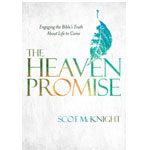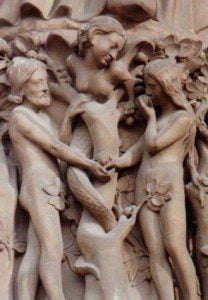One of the most significant questions faced by Christians when confronted by the evidence for an old earth and evolutionary process as the major mechanism of creation is the place Adam and Eve play in the biblical narrative. The CT editorial on the topic began with a rather provocative headline, No Adam, No Eve, No Gospel. When many believe this without nuance or analysis the stakes are high.
 A recent book, Did Adam and Eve Really Exist?: Who They Were and Why You Should Care, by C. John Collins looks at the question of Adam and Eve from a relatively conservative perspective but with some nuance and analysis. The questions he poses and the answers he gives provide a good touchstone for interacting with the key questions. In chapter 2 of the book Collins considers the shape of the biblical story. This includes a discussion of the elements of story and world view, the distinctions between history and myth, and the features of the biblical story.
A recent book, Did Adam and Eve Really Exist?: Who They Were and Why You Should Care, by C. John Collins looks at the question of Adam and Eve from a relatively conservative perspective but with some nuance and analysis. The questions he poses and the answers he gives provide a good touchstone for interacting with the key questions. In chapter 2 of the book Collins considers the shape of the biblical story. This includes a discussion of the elements of story and world view, the distinctions between history and myth, and the features of the biblical story.
According to Collins we should consider the literary characteristics used by the biblical authors the tell their story, in doing so we should also consider the way people use language to make important points (speech act theory), and we should pay careful attention to the overarching narrative or worldview implicit in the writing of the text.
With respect to the literary characteristics used by the authors, Dr. Collins suggests that as we look at the books of the Bible, including Genesis, we should notice the following (p. 24):
- The narrator is reliable and omniscient: that is he serves as the voice and perspective of God.
- The narration is scenic: that is, the emphasis is on direct action and interaction of the characters rather than on descriptive detail of the environs.
- The narratives are sparsely written: that is they focus on what is essential for the narrative.
- The author signals heightened speech using poetic diction: that is, elevated diction of a speech is evidence of its significance, often oracular, it may even be divine speech.
These characteristics, combined with an understanding of the way people use language and the overarching worldview will allow us to read the text for the intended and inspired meaning and intent.
Do you think these characteristics are a good guide?
In particular, do you think the narrator is omniscient? What does this mean for scripture?
In the next section of this chapter Dr. Collins elaborates on the distinction between history and myth in the telling of a worldview story such as that found in Genesis 1-11. To relegate Genesis 1-11 to myth, especially myth in the common understanding of untrue or fiction, he finds unhelpful. Dr. Collins argues extensively that we are wrong to consider the purpose of Genesis 1-11 as theological rather than historical. This is not a story telling “timeless truths,” either timeless moral truths or timeless theological truths but a story pointing back to a cause and effect for the current situation on earth.
Dr. Collins takes this point beyond the story of Adam, Eve, and the Fall. It is an overarching theme. We should not read the stories presented in the Bible looking first and foremost for moral, spiritual, or theological truths to apply to our lives today. This is true when we read of Adam, or Abraham, the story of David and Goliath or the miracles of Jesus. The story of David and Goliath, for example, should not be read as a story to inspire faith in daunting circumstances. It should not even be read as a story of God’s faithfulness if only we trust. Rather this is a story of David as the faithful king when Saul was faithless. There is a historical significance to the event in the grand narrative of scripture.
The real question then is not does the story of Adam and Eve in Genesis 2-3 contain figurative elements in the telling of the story? Dr. Collins would agree that it does. The question is not does the text borrow from Mesopotamian origin stories? Again Dr. Collins would agree that it does. Rather the important question is What is the historical event that the author of Genesis is presenting?
Dr. Collins structures the remainder of this chapter making the argument that the historical event key to Genesis 3 is the idea that God made a good creation and sin is an alien intruder in this good creation. In the discussion of “timeless theological truths” he notes:
scholars thinking along these lines might suppose that Genesis 3 teaches that “humans are sinful.” But this is not a timeless truth on its own: sooner or later someone will want to know, did God create humans with a tendency (or at least an openness) toward sinning, or did he make them good, only for humans to become sinful? If they became sinful, how did that happen? (p. 37)
In the summary at the end of the chapter he concludes:
The Biblical authors therefore portray sin as an alien intruder into God’s good creation. The story of Adam and Eve, and their first disobedience, explains how this intruder first came into human experience, though it hardly pretends to explain how rebellion against God – as expressed in the serpent’s speech – came about in the first place. (p. 49)
Where does this leave us? I agree with Dr. Collins that there is a historical element in Genesis 2-3 and this historical element should not be brushed away with comments about timeless truths and a story of everyman. As in Genesis 1 where there is a historical element behind the form of the story – God created the world for his purpose – so too there is a historical element in the story of the rebellion of mankind. We were created for community and relationship with God, with each other, and with the world. This relationship was ruptured, not because God was unfaithful but because humans, from the very beginning, were unfaithful and wanted to be like God. It seems to me though that God did create humans with an openness toward such sin because in the story Adam and Eve fell almost immediately when presented with the temptation. Others may disagree here, and I would like to hear some of the nuances and reasons.
Did God create humans with an openness for sin? Why do you hold this position?
What do you see as the historical elements in Genesis 2-3?
There is another question I find raised by Dr. Collins’s discussion in this chapter. I think he is right to note that we should not be always searching for theological truths or devotional moral lessons in scripture. In much of scripture we have a story rooted in real historical events and these events are essential for our understanding of where we are today – how we got here and where we are going. This is an element that is sorely lacking in most adult teaching and preaching and most Sunday school curricula for children and youth. We need to be rooted in the story, God’s story. This is a story of his relationship with his creation, his faithfulness, and, all too often, human unfaithfulness.
But all scripture is not historical, and I don’t think we are right to look for historical antecedents everywhere. As examples I would put forth the books of Job and Song of Songs. I think these two books are literature, even “fictional” literature, with a point to the story. These are not elements of the historical narrative of scripture. When we look at Genesis, Genesis 2-3, or more broadly Genesis 1-11, we need to ask about the historicity of some of the elements included in the narrative.
Where do you see history or story included in the text of scripture?
With respect to Genesis 1-11, are these stories with a purpose or are they stylized stories with real historical antecedents? How do you discern the nature and purpose of the text?
If you wish to contact me directly you may do so at rjs4mail[at]att.net
If interested you can subscribe to a full text feed of my posts at Musings on Science and Theology.











